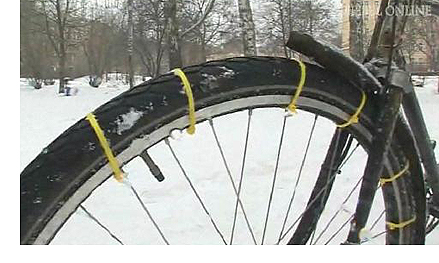
The pioneer adventure cyclists of the 1890s who took to the snowy wilds of northern Canada without the benefit of modern clothing and 80 years before the advent of mountain bikes knew a thing or two about cycling in the extreme cold. The Great Gold Rush drew 100,000 prospectors to the Klondike region of the Yukon in north-western Canada between 1896 and 1899. Those who didn’t have the money to invest in dog teams used bicycles and rudimentary cold weather gear.
19-year-old Max Hirschberg chose to use a bicycle when he joined the gold rush in 1900. His journal gives a fascinating insight into the cold weather gear of the day:
“The day I left Dawson, March 2, 1900, was clear and crisp, 30° below zero. I was dressed in a flannel shirt, heavy fleece-lined overalls, a heavy mackinaw coat, a drill parka, two pairs of heavy woolen socks and felt high-top shoes, a fur cap that I pulled down over my ears, a fur nose piece, plus fur gauntlet gloves. On the handlebars of the bicycle I strapped a large fur robe. Fastened to the springs, back of the seat, was a canvas sack containing a heavy shirt, socks, underwear, a diary in waterproof covering, pencils and several blocks of sulfur matches. In my pockets I carried a penknife and a watch.”
Winter cycling 2015
Cyclists today have the choice of a bewildering choice of technical winter cycling gear, but if you’d rather not spend a considerable amount of money, try a cheap hack to stay toasty if the weather turns bitter.
For as long as cyclists have braved winter conditions, they’ve used newspaper as a cheap and effective way to keep warm. Placing the paper under your top is a fantastically effective way to reduce wind chill and at the end of your ride it can be recycled in the usual way.
 It is possible to buy tyres fitted with metal spikes, but these cost around £50 apiece. Imaginative cyclists can adapt their bikes for icy roads by fitting their bicycle tyres with cables ties. The cable ties take only a few minutes to fit and provide impressive traction on even the most slippery of surfaces. The cable ties are inexpensive to buy, and can be fitted without tools in very little time.
It is possible to buy tyres fitted with metal spikes, but these cost around £50 apiece. Imaginative cyclists can adapt their bikes for icy roads by fitting their bicycle tyres with cables ties. The cable ties take only a few minutes to fit and provide impressive traction on even the most slippery of surfaces. The cable ties are inexpensive to buy, and can be fitted without tools in very little time.
Cable ties cost about 3 pence each and each tyre needs around fifteen ties. Once the period of cold weather has passed they can be cut away and discarded. The technique is suitable for bicycles fitted with disc or hub brakes, but the tyres of any type of bike can be adapted for icy road by covering them with pop rivets. The hack costs less than £2 and further details are available for free at the excellent instructables.com
Year-round protection for your bike
Cycle insurance from the ETA offers year-round protection for you and your bike. It includes new-for-old, third party insurance on any bike you ride , personal accident cover, race event cover and if you suffer a mechanical breakdown, we will come out and recover you and your bike.
0 Comments View now